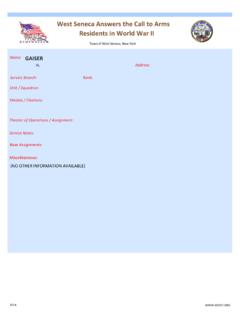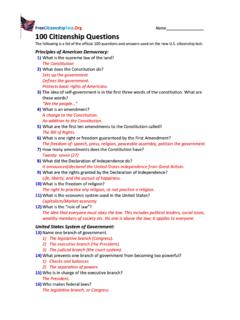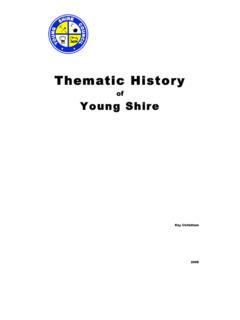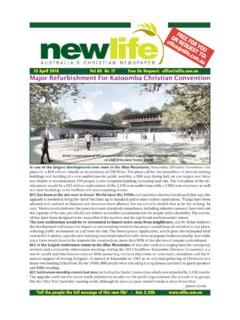Transcription of The Development of International Relations
1 UNESCO EOLSSSAMPLE CHAPTERSINTERNATIONAL Relations The Development of International Relations - Torbj rn L. Knutsen Encyclopedia of Life Support Systems (EOLSS) THE Development OF International Relations Torbj rn L. Knutsen Department of Politics and International Relations , University of Trondheim (NTNU), NORWAY Keywords: anarchy, balance of power, Bretton Woods Agreements, Cold War, colonialism, Concert of Europe, Congress of Vienna, Crimean War, Enlightenment, European Recovery Programme, First World War, French Revolution, Great Powers, Holy Roman Empire, imperialism, industrialization, International society, interstate system, League of Nations, monarchs, Napoleonic Wars, nation, nationalism, Peace of Paris, rights, Potsdam, Russian Revolution, Second World War, Seven Years War, sovereignty, states, superpower, Thirty Years War, Treaty of Westphalia, United Nations, War of Austrian Succession, War of Spanish Succession, Yalta.
2 Contents 1. Pre-state Relations The Decline and Fall of Rome The Role of the Church The Rise of Monarchs and Nobles 2. The Age of the Territorial State The Advent of States The Emergence of the Interstate System The Rise of Modern International Relations The Division of Europe The Modern Interstate System 3. The Age of the Nation State Innovations and World-Wide Wars Reason, Rights and Revolutions Nations at Arms War and Peace The Modern Nation-State System 4. Non-Western Politics Nations, States and Colonies The Last Wave of Expansionism The Age of Imperialism 5. The Twentieth Century Industrialism The Erosion of the Nation-State System First World War The First World War and the Aftermath The World Divided 6.
3 The Post-Cold War World Glossary Bibliography Biographical Sketch UNESCO EOLSSSAMPLE CHAPTERSINTERNATIONAL Relations The Development of International Relations - Torbj rn L. Knutsen Encyclopedia of Life Support Systems (EOLSS) Summary International Relations is a vague and widely used term with two main meanings. The first meaning of term pertains to interactions among states and between states and state-based actors across state boundaries. In this sense, the term can be compared with another widely used term: International politics. However, International Relations is wider than International politics. Thus, the second term is included in the first. Indeed, International politics is usually seen as one of the most important sub-fields of International Relations .
4 This first meaning of the term International Relations was coined by Jeremy Bentham it makes it first appearance in his 1789 book Principles of Morals and Legislation. The second meaning of the term International Relations (IR) denotes a separate field of academic inquiry, distinct from other social sciences like Economics, Law, Sociology etc. This second meaning of the term (IR) effectively originated in 1919 with the establishment of the first chair in the field at the university of Wales, Aberystwyth. This second meaning of the term, then, has the first as its object of scholarly scrutiny. IR has, since its origins in the wake of the First World War, developed several theoretical perspectives in order to identify and explain the recurring patterns of International Relations most notably the causes of war and the preconditions for peace.
5 Many contemporary universities offer courses and degrees in IR; these offerings often cohabit Departments of Political Science together with close academic Relations such as Political Theory, Comparative Politics, Public Policy or International Political Economy. These two meanings are abstract and conventional. In practice, they overlap; it is often hard to tell where one ends and the other begins. This chapter, The Development of International Relations is a case in point. It draws on academic perspectives to present a simple overview of International Relations through modern history. If it draws heavily some might say excessively on Western events, this has a simple explanation: Conventions of the IR discipline singles out the territorial state as the dominant actor in International Relations .
6 Since the territorial state is largely a Western invention the attention of this chapter is biased towards Western events. The chapter begins with a simple overview of the Development of the modern state around the Atlantic rim of the Western world. It then sketches the evolution of political interaction among states and the interaction between states and state-based actors through world history. This narrative is not smooth and steadily evolving. The story slows down a bit at those periods which are marked by important events like the Thirty Years War (1618-1648) and the French Revolution (1789) which are considered turning points in the history of International politics. This chapter delineates the Development of the modern interstate system, but it touches only lightly on its further maturation into an interstate society, as this is discussed by K.
7 J. Holsti in the following chapter. Furthermore, this chapter emphasizes military and economic Relations among individual states, as diplomatic Relations , geopolitical concerns and global-world history are covered in subsequent chapters by G. R. Berridge, S. Dalby and M. G. Fry & A. J. Williams, respectively. UNESCO EOLSSSAMPLE CHAPTERSINTERNATIONAL Relations The Development of International Relations - Torbj rn L. Knutsen Encyclopedia of Life Support Systems (EOLSS) 1. Pre-State Relations Convention identifies territorial states as the major actors of International politics. And as the nature of states has evolved through the ages, so has the nature of International Relations . Where states or nations do not exist, it is hard to identify macro-political affairs that deserve to be denoted as International Relations .
8 Before the age of the modern state, it is difficult to find much evidence of International Relations . Before the age of modern states, macro-political order was imposed by other social formations, such as cities or empires. In Europe, Asia Minor, the Middle East and the north coast of Africa, order and unity were long imposed by the Roman Empire. However, as soon as the Roman Empire began to divide and split in rivaling parts during the course of the fourth century AD, it is possible to distinguish the first foreshadowing of International Relations in the macro-political affairs of the West especially in the fragmented, impoverished western territories that bordered the Atlantic rim. The Decline and Fall of Rome During the fourth century, the politics of the Roman Empire was disintegrating in corruption and increasing disorder.
9 Processes of political deliberation were increasingly overridden by brute force. The empire divided. Armies gained influence. Generals fought each other, sometimes recruiting bands of barbarians to fight for them. As the Empire was increasingly weakened from within, it faced a sudden wave of great migrations (380-450) from without. The eastern half of the Empire survived. The western half, however, collapsed. Western cities faltered. Western industry and commerce decayed. The vast, western territories of the Empire sank back into economic poverty, political fragmentation, and social disorder. The Eastern half of the old Roman Empire retained the basic institutions of Rome. From its splendid capital in Byzants, the East Roman Empire managed to maintain political unity by virtue of Orthodox religion and authoritarian politics.
10 Byzants secured the survival of the eastern Empire partly by repelling the barbarian onslaught by armed force, and partly by deflecting it by diplomacy. Throughout the Middle Ages, Byzants remained the major European city. But the Byzantine Empire closed itself defensively off from the rest of the world, and took no leadership in European events. Thus, it was not from Byzantine politics that the first, significant features of International Relations emerged. The Western half of the Roman Empire, by contrast, unraveled under the impact of the great migrations of the fourth and fifth centuries. Communications halted. Production and trade choked. Two centuries afterwards, Europe had no coherent existence.
















